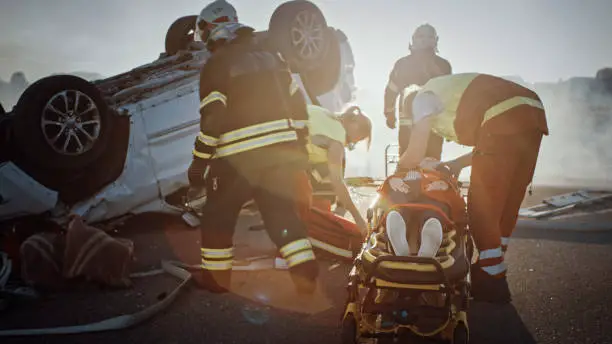Related Posts
An emergency vehicle accident video of a car hitting a police car has been trending on the internet. As you know, a police car is an emergency car. So, given the laws concerning emergency cars, who should be responsible for the accident? Let’s find out.
Who’s at Fault for the Emergency Vehicle Accident?
The video shows the police car crossing an intersection when a gray sedan smashes it, turning it upside down. Nobody is hurt. You can even hear the police officer radioing for assistance. The young man driving the gray car comes down from his car and puts his hands on his head. You can tell that he is scared.
So, celebrity lawyer Ugo Lord answers the question of who is at fault. He said the police officer was at fault for the emergency vehicle accident. According to him, when an emergency vehicle engages its lights and sirens, you are legally obligated to pull over and yield. If you observe the emergency vehicle accident video, you will see that the police officer was responding to another vehicle.
Because the vehicle ran a red light, the police car tried to get it to pull over. However, emergency vehicles must drive with due regard to the safety of the cars around them to avoid an emergency vehicle accident.
The officer must ensure the intersection is clear before crossing, particularly on a red light, even when their lights and sirens are on. Since this officer failed to do so, the police department is responsible.
Things to Know about Emergency Vehicle Accidents in California
If you are a driver in California, you must have come across the California driver handbook. And in the handbook, you will find some rules that all drivers must obey concerning emergency vehicles. They include;
California’s Move Over Law
The California “move over” law requires you to move to another lane or slow down if you see flashing lights on emergency vehicles. Lawmakers provided this law to protect officers and other emergency personnel in accidents.
So when you are driving on the road and see an emergency car coming, change your lane to avoid an emergency vehicle accident. If you cannot do that, you should reduce your speed when passing them. Failing to do this can result in being fined.
California Vehicle Code Section 21806
The law states that you should give way to any police car, ambulance, fire truck, ambulance, or any other emergency vehicle that uses red lights and sirens. For example, if you see an ambulance with its siren and lights coming through an intersection, do not enter it. Allow the ambulance to pass freely without any obstruction.
If you violate this rule, you fail to yield the right of way to an emergency vehicle, and breaking this law can lead to various consequences. You may be required to pay a fine, the amount of which will depend on state and local jurisdictions.
You can also face legal charges if your violation results in an emergency vehicle accident. Points added to your driving record may result in license suspension if the total exceeds a certain threshold. Additionally, insurance rates can increase because insurance companies frequently review traffic violation records when setting policies.
In some cases, authorities may require you to attend traffic school to have the charges against you dropped and to avoid adding points to your driving record. The outcome depends on the specifics of the situation.
Conclusion
Accidents can happen anytime, but that doesn’t mean you should be careless. If you cause an emergency vehicle accident, especially one that could have been avoided, you will face significant consequences. Protect yourself by understanding all traffic laws and driving safely.


[…] all know we must yield to emergency vehicles. When we hear those sirens, we need to stop in our tracks. But what rules must the emergency […]